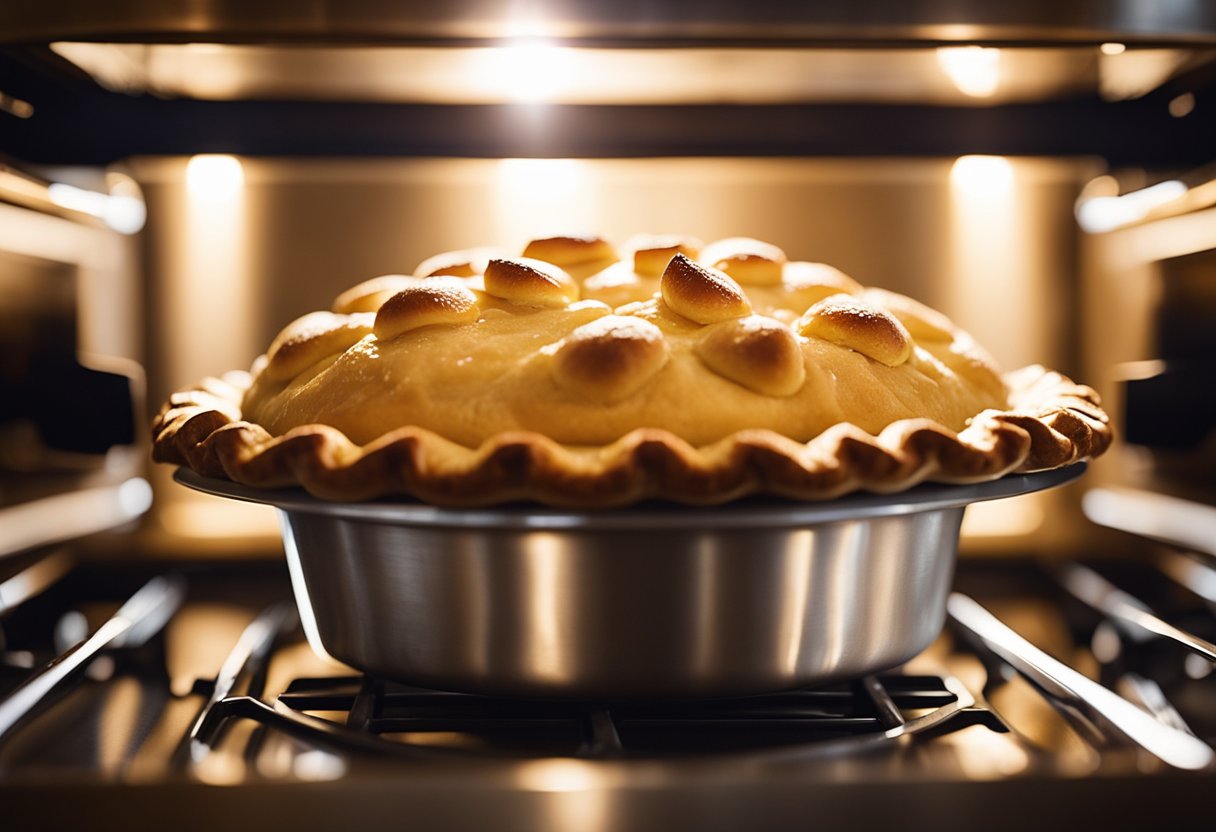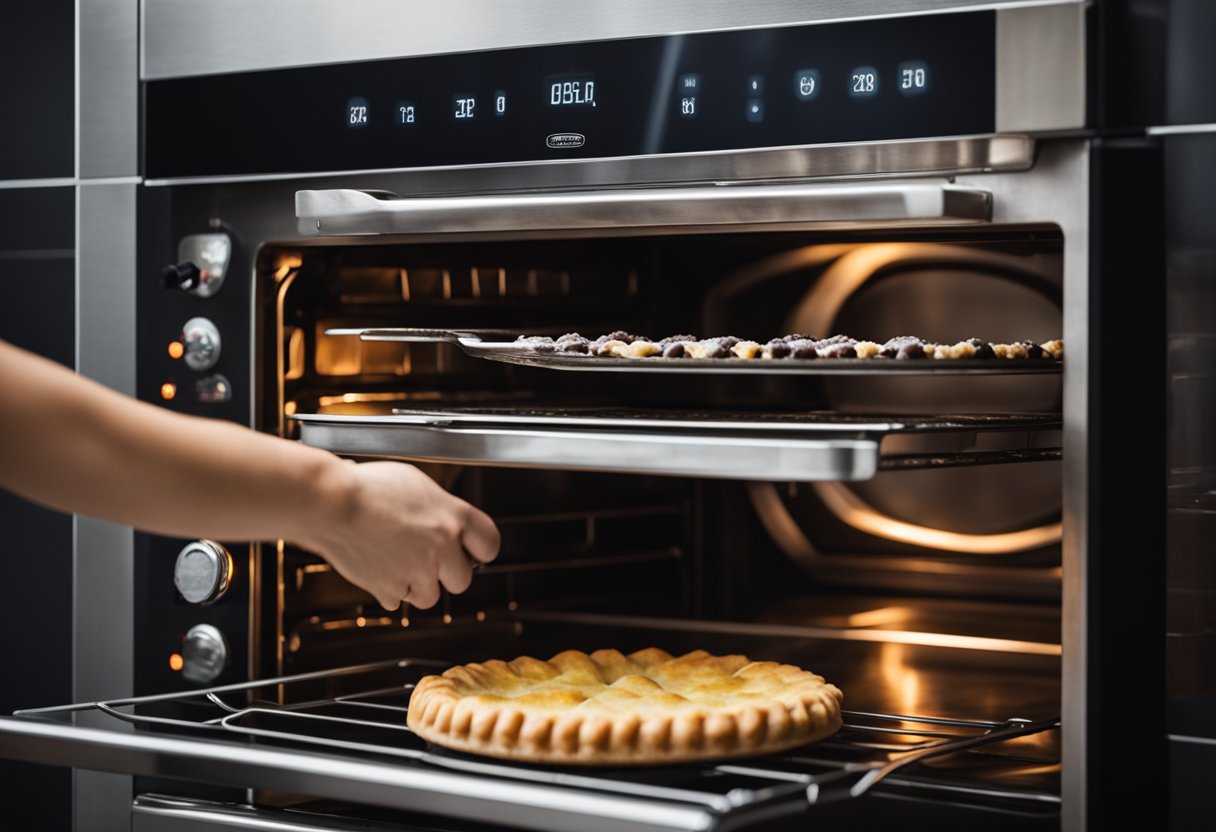Many bakers have faced the disappointment of slicing into a pie only to find that it’s undercooked in the middle. The good news is yes, you can rebake an undercooked pie. The process of rebaking isn’t complicated, but it does require some care to avoid further issues like burning the crust or drying out the filling.

When you discover the pie is not fully baked, it’s essential to act quickly. The temperature and duration of rebaking will depend on the specific pie recipe and the extent to which it is undercooked.
Covering the pie with aluminum foil will prevent the crust from overbrowning while you give the filling more time to bake through. Checking the pie’s doneness before cooling ensures that your efforts in rebaking are successful.
Key Takeaways
- Rebaking an undercooked pie is a feasible solution.
- Proper temperature control and timing are crucial for successful rebaking.
- Aluminum foil can protect the crust from excess browning during the rebaking process.
Understanding Pie Undercooking
When baking pies, the goal is to achieve a perfectly cooked crust and filling. However, there are times when you may encounter undercooking issues.
Common Causes of Undercooked Pies
- Oven Temperature: An oven that’s not properly preheated or set to the incorrect temperature can lead to an undercooked pie.
- Positioning in the Oven: If your pie is positioned too high or too low in the oven, it may cook unevenly.
- Pie Thickness: Thicker pies, particularly those with fruit or custard fillings, often require longer baking times.
Here is a breakdown of potential causes based on pie type:
| Pie Type | Common Undercooking Cause |
|---|---|
| Apple Pie | Thick fillings need more time |
| Pumpkin Pie | Custard density requires even heat |
Identification of Undercooked Pies
- Crust Appearance: A perfect crust is golden brown. If yours is pale, it might be undercooked.
- Filling Consistency: The filling should be set and not runny; this could indicate an undercooked pie, especially in custard or apple pies. To check the doneness of custard pies like pumpkin, perform a knife test by inserting a knife into the filling; it should come out clean.
You can also check for specific advice on apple pie undercooking issues related to pectin and temperature control at How to fix an undercooked apple pie.
By identifying and understanding the common causes and characteristics of an undercooked pie, you can take steps to prevent this issue and adjust your baking process as needed.
Preparations for Rebaking Your Pie

Rebaking an undercooked pie requires careful preparation to ensure success. Attention to the oven’s temperature and the state of your pie is crucial for a perfectly rebaked dessert.
Gathering the Necessary Ingredients
Before you begin, ensure you have all essential ingredients on hand. Depending on the type of pie, this might include items such as:
- Eggs (for egg wash)
- Flour (for thickening)
- Sugar (if additional sweetness is required)
- Aluminum foil (to protect the crust)
Preheating the Oven
Preheat your oven to the correct temperature setting. Typically, set the oven to a temperature slightly lower than the original baking temperature to prevent over-browning. Here are the recommended settings for different pie types:
| Pie Type | Original Baking Temperature | Recommended Rebaking Temperature |
|---|---|---|
| Fruit Pie | 425°F | 350°F |
| Custard Pie | 350°F | 325°F |
| Pecan or Pumpkin Pie | 375°F | 350°F |
Assessing Pie Condition Before Rebaking
Check the condition of your pie. If the filling is still runny, it may require additional flour or time. Should the crust appear too brown, wrap the edges with aluminum foil to shield them. Confirm that the bottom crust is not soggy; if so, a longer preheat period can help to recrisp it.
Keep these steps in mind, and you’ll be well on your way to salvaging that underbaked pie with confidence.
Pie Rebaking Process
When you discover that your pie is undercooked, you can often restore it to perfection by rebaking. The correct approach involves adjusting your oven settings, adequately protecting the pie crust, and carefully monitoring the rebaking time.
Adjusting Oven Settings
Set your oven to a temperature that is lower than the initial baking temperature. This tends to be around 350°F to ensure even heat distribution and prevent the outside from overcooking while the inside finishes. Start by placing your pie on the center rack to encourage uniform cooking.
Protecting the Pie Crust
The edges of your pie crust can overcook while you’re trying to get the center done. To protect them, wrap the edges with aluminum foil or use a crust shield. This will defend against burning and retain the crust’s moisture, giving you a perfectly balanced pie crust.
- Wrap edges loosely with foil.
- Consider investing in a reusable crust shield.
Monitoring the Rebaking Time
Set your timer for an additional 5 to 10 minutes and check the pie at this interval. If the center of the pie still seems too moist, continue rebaking and check every few minutes. Trust your senses; your pie is done when it has a consistent texture and the center is fully cooked.
| Action | Time Interval | Check |
|---|---|---|
| First Check | 5-10 minutes | Pie Center |
| Subsequent Checks | Every few minutes | Crust Color & Texture |
By following these steps, you can rebake a pie to achieve the desired doneness without risking an overcooked crust or uneven baking. Use these guidelines to help secure a successful rebaking process.
Post-Rebaking Tips
Once you’ve successfully rebaked your undercooked pie, it’s crucial to handle the pie properly to ensure the best texture and taste.
These post-rebaking steps will help your pie set properly and prevent issues like a soggy crust or cracks.
Cooling and Setting the Pie
After rebaking, let your pie cool gradually at room temperature on a wire rack. This slow cooling process allows the filling to set and minimizes the risk of the crust becoming soggy. Avoid placing the pie in drafty areas or the refrigerator while it’s still warm, as rapid temperature changes can cause the texture to become uneven or the top to crack.
Storing the Reheated Pie
To store the reheated pie, make sure it has completely cooled to room temperature. Then, wrap the pie gently in plastic wrap or aluminum foil. You can then place the pie in the fridge.
Proper storage helps maintain the pie’s taste and prevents the texture from becoming too moist or dry. If you have particular questions about storage times, you may want to refer to specific guidelines on how to store the reheated pie.
Tips for Avoiding Future Undercooking
To help avoid undercooking in the future, follow these simple tips:
- Verify your oven’s temperature with an oven thermometer to ensure it’s heating accurately.
- Use a glass or dull-metal pie pan for even baking; shiny metal or disposable pans can reflect heat and prevent proper browning and cooking through.
- Bake the pie on the lower oven rack; this helps the bottom crust bake thoroughly before the top crust becomes too brown.
- Rotate the pie halfway through baking to promote even cooking, especially if your oven has hot spots.
Remember to check for doneness before you remove the pie from the oven, which will help you know whether the pie requires more time. If the pie is golden brown but the filling doesn’t seem set, you can cover the edges with foil and continue to bake.
Troubleshooting Common Issues
When a pie turns out undercooked, it can put a damper on your baking success, but there are reliable ways to address common issues without starting over from scratch.
Fixing Runny Filling
Runny fillings in custard pies or fruit pies like apple can often be the result of under-baking. To fix your pie’s runny filling, place it back in the oven for a few additional minutes. If you’re dealing with a pecan pie, you can return it to the oven covered with aluminum foil to avoid burning while the filling sets.
- Custard Pie: If your custard pie filling is still runny, consider baking it in five-minute intervals, checking for doneness each time.
- Fruit Pie: With fruit pies, it’s beneficial to check if there’s enough thickener in your recipe, as that can be a culprit for runniness.
Dealing with Potential Overcooking Risks
To mitigate the risk of overcooking your pie, which can lead to a tough and soggy crust, carefully monitor the pie’s progress as you rebake it. Cover the edges with tin foil or a pie shield if they are browning too quickly. Here’s a simple trick: Once the filling bubbles, reduce the heat and let the pie finish baking at a lower temperature.
- Preheat the oven to the temperature initially prescribed by your pie recipe.
- Cover the crust edges with foil.
- Place the pie back in the oven, reducing the temperature by 25 degrees to avoid over-browning.
Handling Crust and Texture Problems
The crust is crucial to a pie’s final texture. If your pie crust is undercooked, it can result in a soggy bottom. Return the pie to the oven and bake at a slightly higher temperature. For instance, if you were baking at 350°F, increase to 375°F, and keep an eye on the crust as it finishes cooking.
- For preventing a soggy bottom: Consider pre-baking your crust before adding the filling.
- To address a soggy bottom: Increase the heat slightly to help the crust cook through without burning the top.
| Issue | Solution | Notes |
|---|---|---|
| Runny filling | Rebake with intervals, check frequently | Use thickening agents for fruit pies, consider foil to prevent further browning |
| Browning edge | Cover with foil, lower oven temperature | Keep the filling uncovered while protecting the crust |
| Soggy crust | Increase oven temperature, bake until golden | Pre-baking the crust can prevent sogginess, tin foil can shield overly brown crust edges |
Remember, patience and attention to detail can rescue an undercooked pie, ensuring that your dessert is saved and savored.
Conclusion

If your pie emerges undercooked, don’t fret. Correcting this issue is a simple process. When you rebake an undercooked pie, remember these key points:
- Preheat your oven to the original baking temperature.
- Place the pie back in the oven for about 10-15 minutes.
- Check for doneness by inserting a knife into the pie center.
Monitor the pie carefully during the additional baking time to prevent overcooking. If necessary, cover the edges with aluminum foil to avoid burning—particularly for a store-bought pie which might require delicate handling.
Remember:
- Allow the pie to settle after rebaking to ensure proper consistency.
- There’s no shame in using a kitchen timer for that extra reminder.
Armed with this method, you’re well-equipped to save an undercooked pie, ensuring it’s perfectly baked for your enjoyment.

